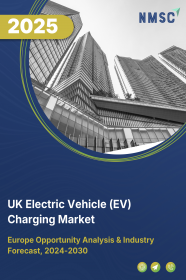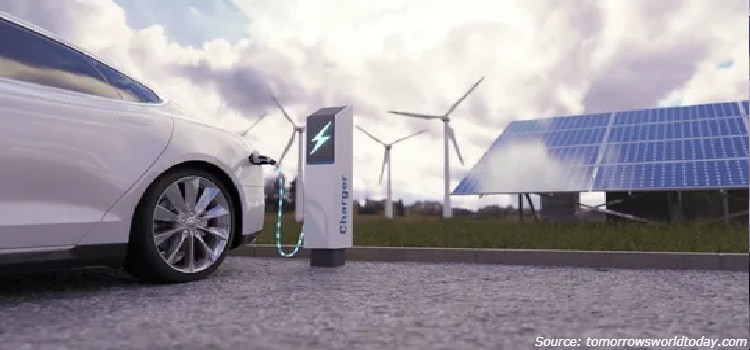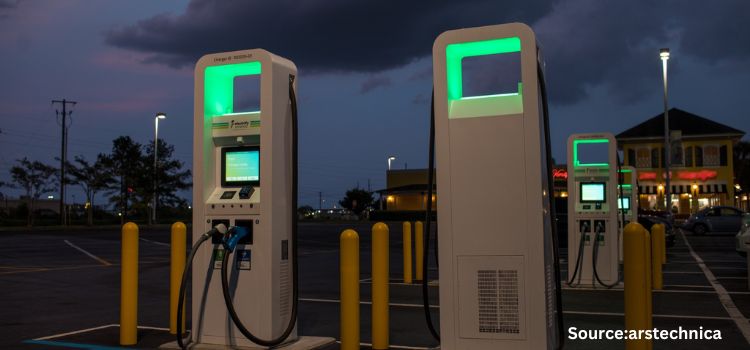
UK Electric Vehicle (EV) Charging Market by Type of Charger (AC Chargers, and DC Chargers), by Charging Speed (Level 1, Level 2, and Level 3), by Connector Type (J1772 (Type 1), Mennekes (Type 2), CCS (Combined Charging System), CHAdeMO, and Others), by Charging Modes (Mode 1, Mode 2, Mode 3, and Mode 4), by Installation (Fixed, and Portable), and by End User (Commercial, and Residential) – Opportunity Analysis and Industry Forecast 2023–2030
Industry: Automotive & Transportation | Publish Date: 26-May-2025 | No of Pages: 153 | No. of Tables: 116 | No. of Figures: 61 | Format: PDF | Report Code : AT849
US Tariff Impact on UK Electric Vehicle (EV) Charging Market
Trump Tariffs Are Reshaping Global Business
Market Definition
UK Electric Vehicle (EV) Charging Market was valued at USD 612.42 million in 2022, and is predicted to reach USD 4986.0 million by 2030, with a CAGR of 30.7% from 2023 to 2030. Electric vehicle chargers are defined by the amount of energy delivered to the vehicle’s battery per unit of time. It is an infrastructure that is used to connect the plug-in electric vehicle to an electrical outlet to charge the battery of the vehicle. Electric vehicle chargers are used to provide charging to EVs with a battery and the electrical source that helps to charge the battery.
Electric vehicles, neighborhood EVs, and plug-in hybrids can all be charged at a charging station by connecting to an electrical source. Advanced features including smart meters, cellular connectivity, and network access are available on some charging stations.
The charging of EVs can be carried out through several levels of charging such as level 1, level 2, and level 3. The higher the level of charging, the faster the charging process causing more power to be delivered to the vehicle. The use of electric vehicles significantly reduces the carbon footprints released into the atmosphere, which contain toxic gas. The growing threat of carbon emissions and other harmful gases stemming from transportation has triggered the vital necessity of adopting electric vehicles.
In addition, the penetration of EV charging is high in commercial spaces as compared to residential ones. Long-distance trips would benefit from ultra-fast charging capabilities made possible by public charging infrastructure. However, EV chargers for residential spaces offer significant growth potential as they are affordable and more convenient for charging electric vehicles as compared to commercial charging stations.
UK Government Backs Electric Vehicle Charging Infrastructure To Achieve Net Zero Goals
The UK government is actively supporting the expansion of EV charging infrastructure to meet its net zero emissions target by 2050. In August 2022, it launched the Local EV Infrastructure (LEVI) pilot scheme, allocating nearly £20 million to install over 1,000 public chargepoints across nine local authorities in England. This initiative is part of a broader £450 million LEVI fund aimed at enhancing local charging networks.
As of March 2025, the UK boasts over 75,000 public EV chargepoints, with a new charger added approximately every 29 minutes. The government has committed more than £2.3 billion to support the transition to electric vehicles, including a £381 million LEVI fund launched in March 2023 to accelerate infrastructure rollout. These efforts aim to reach the target of 300,000 public chargepoints by 2030, ensuring widespread accessibility and supporting the growing number of EV users.
Increasing Corporate Adoption Drives Growth In The Ev Charging Station Market
Corporate investments and partnerships are significantly propelling the growth of the EV charging station market in the UK. Companies like Connected Kerb have secured substantial funding—£65 million from the National Wealth Fund and Aviva Investors—to expand their charging networks from 9,000 to 40,000 sockets, aiming to become the UK's largest public charging network by 2025.
Furthermore, the UK government emphasizes the importance of private sector involvement, expecting it to contribute the majority of investment required to meet the ambitious target of 300,000 public chargepoints by 2030. This collaborative approach between public initiatives and private enterprises is crucial for accelerating the development and accessibility of EV charging infrastructure, thereby supporting the nation's transition to sustainable transportation.
Fast Chargers' High Initial Setup Costs Hinder The Ev Charging Market Growth
Lack of incentives and worries about the high installation costs of EV charger installation could prevent the growth of the sector. One of the biggest barriers to the expansion of this business is the high initial cost of level 3 and ultra-fast chargers. While level 1 and level 2 chargers can take anything from 6 to 16 hours to fully charge, consumers typically charge their fossil fuel vehicles in 5 to 7 minutes. Fast chargers that can charge EVs in under 30 minutes are therefore in demand on the market. A level 3 charging station can be somewhat expensive at first, though. For those who might want to transition to EVs, this could be a deterrent because a lengthy charging period might interfere with their already hectic schedules.
Surging Adoption Of Vehicle-to-grid (V2G) Ev Charging Stations In The Uk Unlocks Promising Opportunities
Vehicle-to-Grid (V2G) technology enables bidirectional energy flow between electric vehicles (EVs) and the power grid. EVs can store energy and discharge it back into the grid when needed, helping balance electricity demand, support grid stability, and reduce energy costs.
In the UK, V2G is gaining traction as part of the country's smart grid and decarbonisation strategy. Trials such as the "Electric Nation V2G" project and "Project Sciurus" (involving Ovo Energy, Nissan, and Cenex) have demonstrated the commercial and technical feasibility of V2G systems.
This emerging technology presents a significant opportunity for:
- EV owners to earn revenue or savings by selling stored energy back to the grid.
- Grid operators to manage peak demand more efficiently.
- EV charging infrastructure providers to offer premium, grid-integrated services.
- Connector and hardware manufacturers to develop next-generation V2G-compatible solutions that meet grid communication and power standards.
While high initial setup costs and standardisation issues remain a challenge, the UK’s ongoing investments in smart grid infrastructure and supportive regulatory framework (such as Ofgem's flexibility markets and National Grid’s participation in trials) create a favorable environment for V2G growth.
Competitive Landscape
The UK Electric Vehicle (EV) Charging industry includes several market players such as Tesla Inc., Pod Point, ABB Ltd., MFG EV Power, InstaVolt, Shell Recharge, WallBox Inc., Gridserve, Schneider Electric, Siemens, EVBox, BP Pulse, RAW Charging, Fastned UK, and Hypervolt Inc.
Key Benefits
-
The UK Electric Vehicle (EV) Charging market report provides a quantitative analysis of the current market and estimations through 2023-2030 that assists in identifying the prevailing market opportunities to capitalize on.
-
The study comprises a deep dive analysis of the market trend including the current and future trends for depicting the prevalent investment pockets in the market.
-
The information related to key drivers, restraints, and opportunities and their impact on the market is provided in the report.
-
The competitive analysis of the market players along with their market share in the UK Electric Vehicle (EV) Charging market.
-
The SWOT analysis and Porter’s Five Forces model are elaborated in the study.
-
Value chain analysis in the market study provides a clear picture of the stakeholders’ roles.
UK Electric Vehicle (EV) Charging Market Key Segments
By Type of Charger
-
AC Chargers
-
DC Chargers
By Charging Speed
-
Level 1
-
Level 2
-
Level 3
By Connector Type
-
J1772 (Type 1)
-
Mennekes (Type 2)
-
CCS (Combined Charging System)
-
CHAdeMO
-
Others
By Charging Modes
-
Mode 1
-
Mode 2
-
Mode 3
-
Mode 4
By Installation
-
Fixed
-
Portable
By End User
-
Commercial
-
Commercial Public EV Charging Stations
-
Highway Charging Stations
-
Fleet Charging Stations
-
Workplace Charging Stations
-
-
Commercial Private EV Charging Stations
-
-
Residential
Key Players
-
Tesla Inc.
-
Pod Point
-
ABB Ltd.
-
MFG EV Power
-
InstaVolt
-
Shell Recharge
-
WallBox Inc.
-
Gridserve
-
Schneider Electric
-
Siemens
-
EVBox
-
BP Pulse
-
RAW Charging
-
Fastned UK
-
Hypervolt Inc.
REPORT SCOPE AND SEGMENTATION:
|
Parameters |
Details |
|
Market Size in 2022 |
USD 612.42 Million |
|
Market Volume in 2022 |
56 Thousand Units |
|
Revenue Forecast in 2030 |
USD 4986.0 Million |
|
Growth Rate |
CAGR of 30.7% from 2023 to 2030 |
|
Analysis Period |
2022–2030 |
|
Base Year Considered |
2022 |
|
Forecast Period |
2023–2030 |
|
Market Size Estimation |
Million (USD) |
|
Growth Factors |
UK Government Backs Electric Vehicle Charging Infrastructure To Achieve Net Zero Goals Increasing Corporate Adoption Drives Growth In The Ev Charging Station Market |
|
Companies Profiled |
15 |
|
Market Share |
Available for 10 companies |
|
Customization Scope |
Free customization (equivalent up to 80 working hours of analysts) after purchase. Addition or alteration to country, regional, and segment scope. |
|
Pricing and Purchase Options |
Avail customized purchase options to meet your exact research needs. |

















 Speak to Our Analyst
Speak to Our Analyst





















